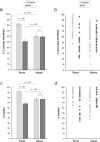Normal recognition of famous voices in developmental prosopagnosia
- PMID: 33184411
- PMCID: PMC7661722
- DOI: 10.1038/s41598-020-76819-3
Normal recognition of famous voices in developmental prosopagnosia
Abstract
Developmental prosopagnosia (DP) is a condition characterised by lifelong face recognition difficulties. Recent neuroimaging findings suggest that DP may be associated with aberrant structure and function in multimodal regions of cortex implicated in the processing of both facial and vocal identity. These findings suggest that both facial and vocal recognition may be impaired in DP. To test this possibility, we compared the performance of 22 DPs and a group of typical controls, on closely matched tasks that assessed famous face and famous voice recognition ability. As expected, the DPs showed severe impairment on the face recognition task, relative to typical controls. In contrast, however, the DPs and controls identified a similar number of voices. Despite evidence of interactions between facial and vocal processing, these findings suggest some degree of dissociation between the two processing pathways, whereby one can be impaired while the other develops typically. A possible explanation for this dissociation in DP could be that the deficit originates in the early perceptual encoding of face structure, rather than at later, post-perceptual stages of face identity processing, which may be more likely to involve interactions with other modalities.
Conflict of interest statement
The authors declare no competing interests.
Figures



Similar articles
-
Holistic face perception is impaired in developmental prosopagnosia.Cortex. 2018 Nov;108:112-126. doi: 10.1016/j.cortex.2018.07.019. Epub 2018 Aug 6. Cortex. 2018. PMID: 30165324
-
Impaired body perception in developmental prosopagnosia.Cortex. 2017 Aug;93:41-49. doi: 10.1016/j.cortex.2017.05.006. Epub 2017 May 25. Cortex. 2017. PMID: 28618296
-
Impaired perception of facial emotion in developmental prosopagnosia.Cortex. 2016 Aug;81:126-36. doi: 10.1016/j.cortex.2016.04.008. Epub 2016 Apr 21. Cortex. 2016. PMID: 27208814
-
Electrophysiological studies of face processing in developmental prosopagnosia: neuropsychological and neurodevelopmental perspectives.Cogn Neuropsychol. 2012;29(5-6):503-29. doi: 10.1080/02643294.2012.716757. Epub 2012 Oct 16. Cogn Neuropsychol. 2012. PMID: 23066851 Review.
-
Disentangling developmental prosopagnosia: A scoping review of terms, tools and topics.Cortex. 2024 Jul;176:161-193. doi: 10.1016/j.cortex.2024.04.011. Epub 2024 May 15. Cortex. 2024. PMID: 38795651
Cited by
-
The Twenty Item Prosopagnosia Index (PI20) provides meaningful evidence of face recognition impairment.R Soc Open Sci. 2021 Nov 3;8(11):202062. doi: 10.1098/rsos.202062. eCollection 2021 Nov. R Soc Open Sci. 2021. PMID: 34737872 Free PMC article.
-
This condition impacts every aspect of my life: A survey to understand the experience of living with developmental prosopagnosia.PLoS One. 2025 Apr 30;20(4):e0322469. doi: 10.1371/journal.pone.0322469. eCollection 2025. PLoS One. 2025. PMID: 40305451 Free PMC article.
-
Familial Transmission of Developmental Prosopagnosia: New Case Reports from an Extended Family and Identical Twins.Brain Sci. 2024 Jan 4;14(1):49. doi: 10.3390/brainsci14010049. Brain Sci. 2024. PMID: 38248264 Free PMC article.
-
Neural Correlates of Voice Learning with Distinctive and Non-Distinctive Faces.Brain Sci. 2023 Apr 7;13(4):637. doi: 10.3390/brainsci13040637. Brain Sci. 2023. PMID: 37190602 Free PMC article.
-
The impact of low vision on social function: The potential importance of lost visual social cues.J Optom. 2023 Jan-Mar;16(1):3-11. doi: 10.1016/j.optom.2022.03.003. Epub 2022 May 12. J Optom. 2023. PMID: 35568628 Free PMC article. Review.
References
Publication types
MeSH terms
Grants and funding
LinkOut - more resources
Full Text Sources
Research Materials

